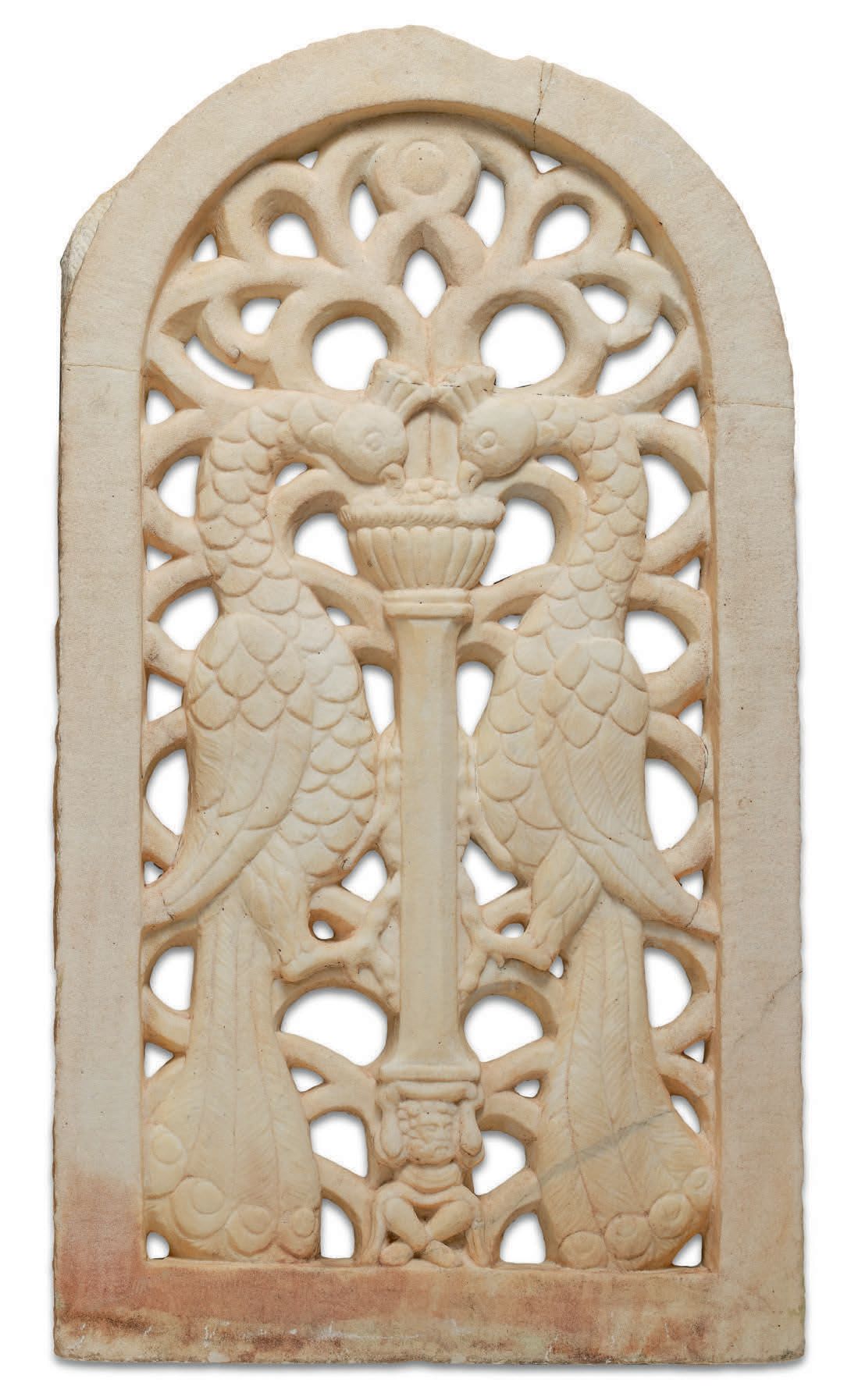Description
TWO MONUMENTAL CLAUSTRAS or windows in white marble carved with an openwork design depicting interlacing Tree of Life motifs accompanied by two peacocks facing each other on one side and two lions also facing each other on the other, the animal couples with bent heads in a basket of abundant fruit perched on a central canted column supported by a bearded figure seated cross-legged. Italy, Venice, 12th or 13th century. Heights: 103 and 104 cm - Widths: 57 cm Depths: 8 cm (Homogeneous erosion, restorations) "To him who overcomes, I will give to eat of the Tree of Life, which is in the paradise of God." (Ap. 2,7) The use of the Tree of Life in Venetian iconography bears witness to the influence of Byzantine art on Venetian culture and aesthetics. The Byzantine Empire exerted great influence on the Republic of Venice, particularly in political, commercial and artistic terms. Exchanges between the two cultures fostered the emergence of a unique style in Venice, where Byzantine art and Venetian taste merged to create remarkable artistic masterpieces. The Tree of Life is often interpreted as a symbol of fertility, regeneration and immortality. It represents eternal life and the connection between the earthly world and the divine. In Byzantine iconography, the Tree of Life is associated with Paradise, the Garden of Eden and the presence of God. It is most often surrounded by birds, flowers and other elements of nature, such as lions and peacocks, reinforcing the symbolism of vitality and prosperity. This subject is usually expressed in more or less elaborate bas-reliefs, but the expression of the Tree of Life in clerestory panels is particularly rare, and the only comparable occurrence is on the occulo of the Basilica of Santa Maria in the Abbey of Pomposa (shown opposite).
29
TWO MONUMENTAL CLAUSTRAS or windows in white marble carved with an openwork design depicting interlacing Tree of Life motifs accompanied by two peacocks facing each other on one side and two lions also facing each other on the other, the animal couples with bent heads in a basket of abundant fruit perched on a central canted column supported by a bearded figure seated cross-legged. Italy, Venice, 12th or 13th century. Heights: 103 and 104 cm - Widths: 57 cm Depths: 8 cm (Homogeneous erosion, restorations) "To him who overcomes, I will give to eat of the Tree of Life, which is in the paradise of God." (Ap. 2,7) The use of the Tree of Life in Venetian iconography bears witness to the influence of Byzantine art on Venetian culture and aesthetics. The Byzantine Empire exerted great influence on the Republic of Venice, particularly in political, commercial and artistic terms. Exchanges between the two cultures fostered the emergence of a unique style in Venice, where Byzantine art and Venetian taste merged to create remarkable artistic masterpieces. The Tree of Life is often interpreted as a symbol of fertility, regeneration and immortality. It represents eternal life and the connection between the earthly world and the divine. In Byzantine iconography, the Tree of Life is associated with Paradise, the Garden of Eden and the presence of God. It is most often surrounded by birds, flowers and other elements of nature, such as lions and peacocks, reinforcing the symbolism of vitality and prosperity. This subject is usually expressed in more or less elaborate bas-reliefs, but the expression of the Tree of Life in clerestory panels is particularly rare, and the only comparable occurrence is on the occulo of the Basilica of Santa Maria in the Abbey of Pomposa (shown opposite).
